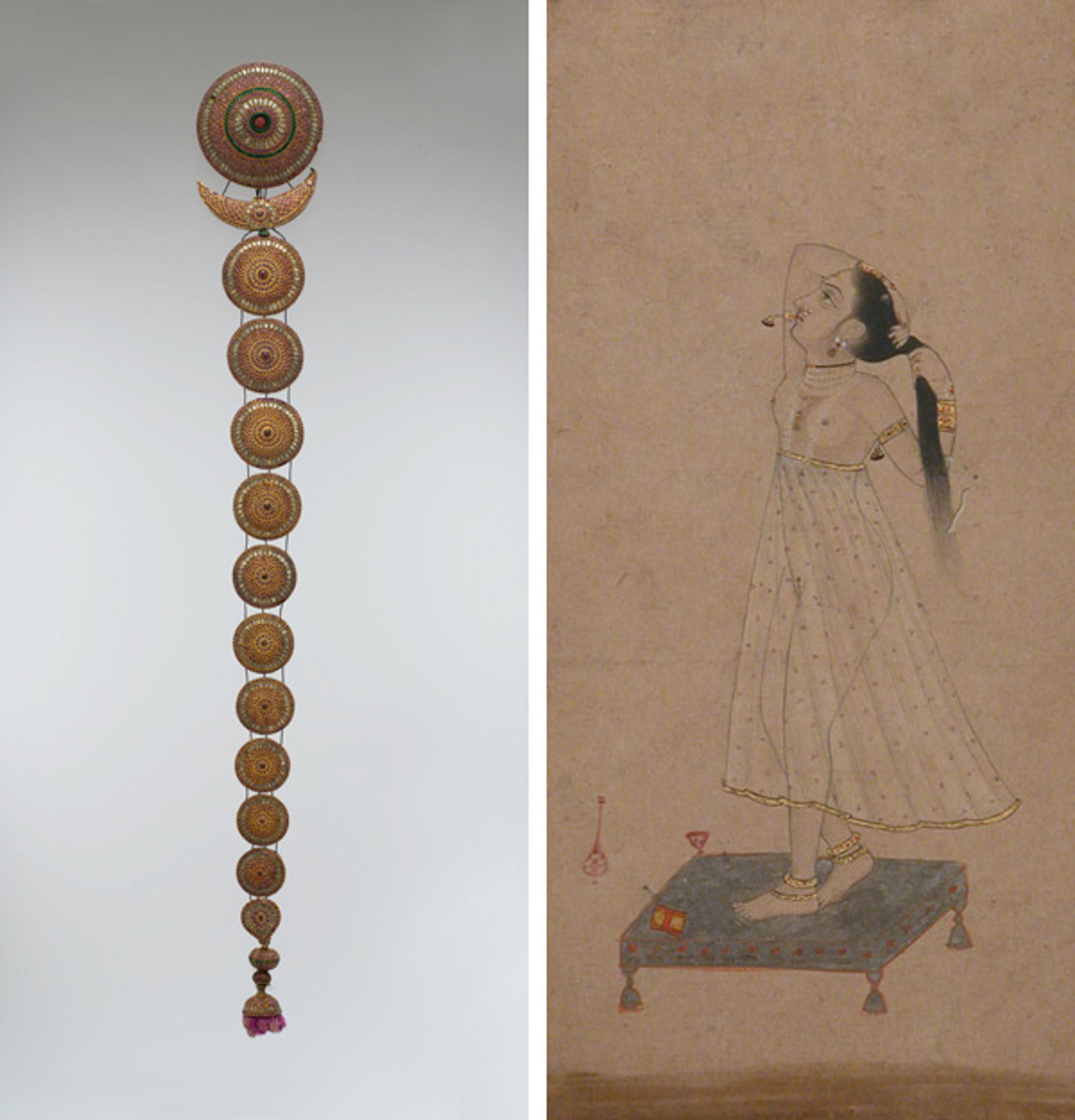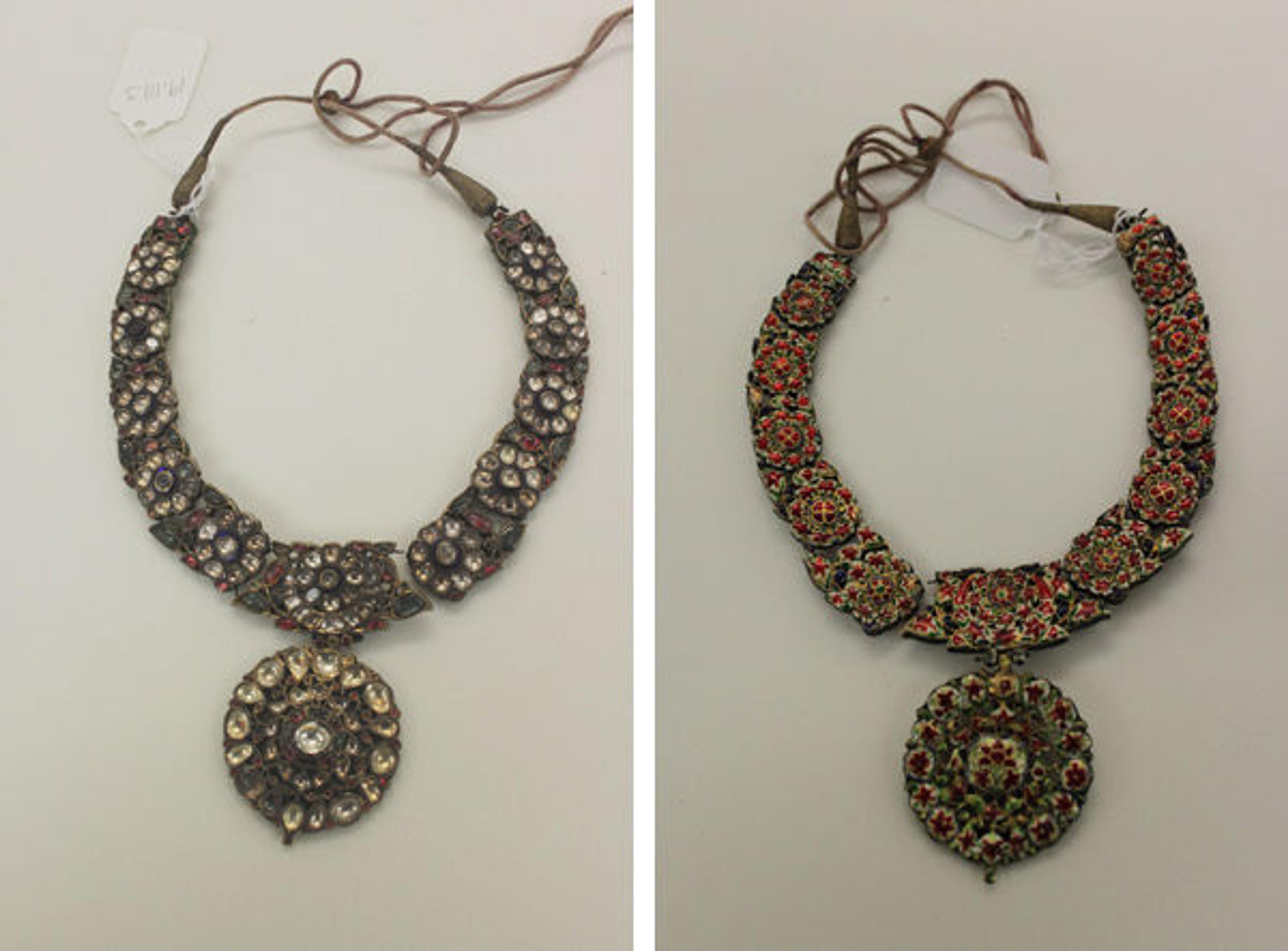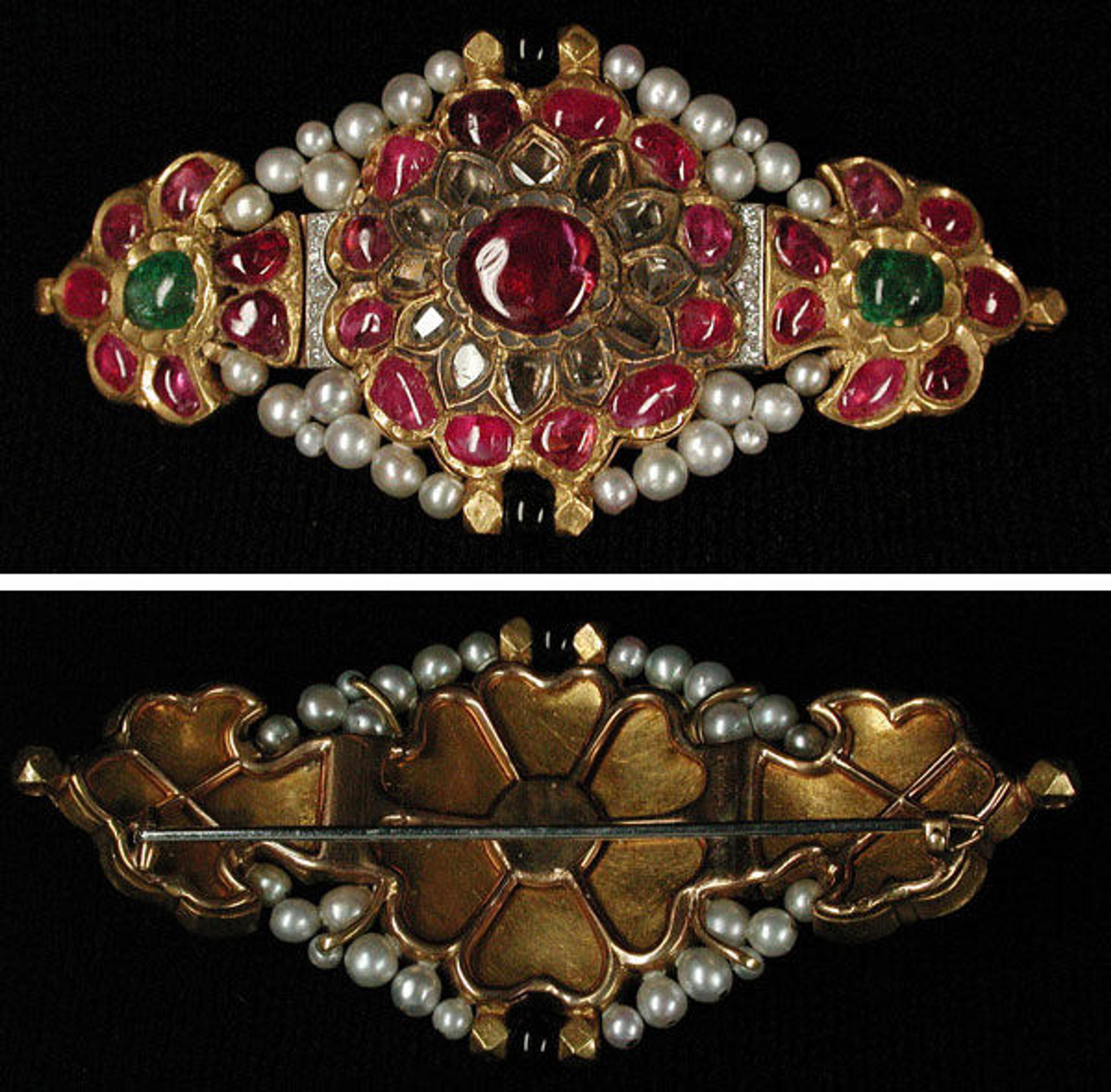Three Jewels from South Asia

Left: Plait ornament (jadanagam), 18th–19th century. India, probably Madras. Islamic. Gold; inset with rock crystal, rubies, emeralds, and amethysts; L. 23 3/4 in. (60 cm), Max. W. 3 1/4 in. (8 cm). The Metropolitan Museum of Art, New York, Rogers Fund, 1919 (19.111.4). Right: Lady Dressing Her Hair, late 18th century. India. Islamic. Ink, opaque watercolor, and gold on paper; 6.87 x 3.94 in. (17.5 x 10 cm). The Metropolitan Museum of Art, New York, Gift of Richard Ettinghausen (1975.192.5)
«
"O your hair," he said,
"it's like rainclouds
moving between branches of lightning.
It parts five ways
between gold ornaments
braided with a length of flowers
and the fragrant screwpine . . ."
So wrote the Tamil poet Kapilar, nearly two thousand years ago, of the beauty of a woman's braid adorned with jewels and sweet flowers. In the Department of Islamic Art, there is one such gold ornament, a jadanagam from eighteenth- or nineteenth-century South India on view in gallery 463, that never fails to bring me to a thrilled standstill as it shimmers under the light. Intended to adorn a woman's plait, or braid, the jadanagam features a large disc at the top that the wearer would secure to the back of her head with black cord, and a crimson silk tassel at its base to mark the end of the braid. The name alone suggests a graceful sinuousness: in Tamil, jadai refers to the braid and nagam means "snake." Combined with garlands of fragrant jasmine, the jadanagam—as Kapilar's poem suggests—would have made for a heady, mesmerizing effect.»
Such pieces are sometimes made in the shape of an actual snake or a garland of flowers, but the jadanagam in the Met's collection comprises a series of exquisitely jeweled gold discs that taper in size down the length of the plait. At the top is a large, slightly convex disc flanked by a crescent, which together represent the sun and the moon, popular motifs in the traditional jewelry of South India. The delicate droplet shape at the very base of the jadanagam suggests a leaf from the pipal tree sacred to Hindus.
To produce the shimmering, gem-laden effect of the jadanagam, craftsmen employed a technique called kundan. In this method, gold or silver was drawn into wire, then beaten into flat strips. From there, these foils were folded into ribbons and compressed to form a solid wedge around the gemstone that would hold the stone in place. In some cases, the reverse side was covered in engraved designs.

Necklace (front at left, reverse at right), 18th century. India, probably Jaipur. Gold, colored stones, enamel, silk; Ornament: H. 7 7/8 in. (20 cm), W. 6 in. (15 cm). The Metropolitan Museum of Art, New York, Rogers Fund, 1919 (19.111.3)
In other examples, such as the necklace above, the kundan was paired with enamel designs on the reverse. In minakari (an Indian term for this type of enameling), which came into prominence during the Mughal period, enamel was used to embellish the back of jewelry in colorful patterns or flower motifs. Likely created in northern India during the eighteenth century, this piece features an abstract floral design composed of stones set in gold. The reverse shows a pattern of a red flowers over a white enamel field; this side would have rested against the wearer's skin or clothing—invisible while worn, a private pleasure perhaps intended foremost for the wearer's eyes.
Around the corner from the jadanagam in the gallery is another piece of striking kundan jewelry. Likely also produced in eighteenth- or nineteenth-century Northern India, this piece would have been originally created as a bazuband. Bazubands, or arm bands, were worn by both men and women in India and Iran, as is visible in the drawing at the top of this post. In the early twentieth century, this particular bazuband was transformed into a brooch by the French jewelry house Cartier: the line of pearls and pair of onyx beads encircling the central pendant and the small diamonds set in platinum would then have been added, in addition to the pin fastening at the rear (in lieu of the chain or cord, which would have originally functioned to secure the bazuband around an arm).

Centerpiece from an armlet (bazuband) later made into a brooch (front at top, reverse at bottom), 18th–19th century. Northern India. Islamic. Gold, inset with rubies, emeralds, and colorless sapphires; with later pearls, diamonds, onyx; L. 3 3/4 in., W. 2 in. The Metropolitan Museum of Art, New York, Gift of George Blumenthal, 1941 (41.100.118)
In the early twentieth century, European jewelry houses exhibited a greater interest in the Indian gems and motifs, while Indian royals became increasingly interested in Western styles. European and American firms drew upon Indian designs for the Western markets, creating and resetting pieces for Indian rulers. Chief among these producers was Cartier, which sought to adapt traditional Indian motifs into a Western design idiom. This particular bazuband/brooch eventually ended up in the collection of George Blumenthal, a German-born banker who served as the seventh president of the Met, who bequeathed it to the Museum as part of a much larger art collection upon his death, in 1941.
The necklace and jadanagam above, meanwhile, came from the collection of Lockwood de Forest, a painter and collector of Indian objects. De Forest, who was deeply interested in traditional Indian arts and crafts, often employed local craftsmen in the subcontinent to produce goods for export to the United States. He maintained several showrooms in New York in addition to working as an independent interior designer. The Museum obtained quite a few pieces from him, and acquiring these two objects in 1919.
One of the great pleasures of viewing any gallery is the surprising—or simply delightful—juxtapositions of objects that often have had very different lives. The sheer size of the permanent collection at the Met allows for many particularly wondrous arrangements and pairings, so I invite you to take a stroll through the galleries to discover what might captivate or startle your eye.
References
Bala Krishnan, Usha R., and Meera Sushil Kumar. Indian Jewellery: Dance of the Peacock. Bombay: India Book House Limited, 2001.
Bala Krishnan, Usha R. Jewels of the Nizams. New Delhi: Department of Culture, Government of India, 2001.
Taylor, Francis Henry. "In Memoriam: George Blumenthal 1858–1941." In The Metropolitan Museum of Art Bulletin 36, no. 7 (1941): 145–147.
Jenkins, Marilyn, and Manuel Keene. Islamic Jewelry in The Metropolitan Museum of Art. New York: Metropolitan Museum of Art, 1983.
Mayer, Roberta A. "The Aesthetics of Lockwood de Forest: India, Craft, and Preservation." In Winterthur Portfolio 31, no. 6 (1996): 1–22.
Ramanujan, A. K., ed. Poems of Love and War: From the Eight Anthologies and the Ten Long Poems of Classical Tamil. New York: Columbia University Press, 1985.
Untracht, Oppi. Traditional Jewelry of India. New York: Harry N. Abrams, 1997.
Young-Sánchez, Marguerite. Cartier in the 20th Century. New York: Denver Art Museum in Association with Vendome Press, 2014.
Related Link
Now at the Met: "In the Stars: Gems and the Indian Tradition" (December 17, 2014)
Harita Koya
Harita Koya is an intern in the Department of Islamic Art.